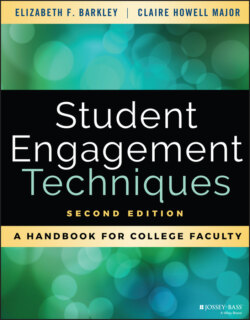Читать книгу Student Engagement Techniques - Elizabeth F. Barkley - Страница 55
Condition 2: Teachers Can Create Synergy by Helping Students Work at Their Optimal Level of Challenge
ОглавлениеOne of the fundamental principles of learning is that tasks must be sufficiently difficult to pose a challenge, but not so difficult as to destroy the willingness to try (McKeachie, 1994, p. 353). Somewhere between “been there, done that” and “dazed and confused” lies the optimal level of challenge that engages students. Vygotsky (1978) coined the term zone of proximal development (ZPD) to suggest that learning is productive when learners are operating in a situation that exposes them to concepts and ideas just slightly above their current level of development. The theory, applied to student engagement, suggests that engaged learning occurs in the gap between a learner's current understanding and potential understanding. Working at the optimal challenge level creates synergy because it straddles both motivation and active learning.
In terms of motivation, Brophy (2004) suggests that anxiety and a mismatch of task to skill are the chief threats to the flow potential that characterizes deep engagement. When students face challenging tasks but do not think they possess the necessary skills, they experience anxiety; when skill is high but the task is not challenging, students become bored; when both challenge and skill level are low, students become apathetic. All three qualities—anxiousness, boredom, and apathy—characterize lack of engagement. From the perspective of active learning, an important aspect of schema theory is that the mind not only decodes what is said or written and makes the connections to existing knowledge, but also that it supplies much that is not present.
Cross (1993c) describes work done by Crawford and Chaffin (1986), who offer the simple sentence, “The little girl heard the ice cream man and rushed upstairs to get her piggy bank.” Most of us reading that sentence know what it means, even though the sentence itself says nothing about ice cream vendors moving along the street, ringing a bell, about liking or buying ice cream, or about a piggy bank containing money. The reader supplies that information from past experience, and makes the interpretation based on what he or she already knows. To someone raised on a ranch in Wyoming, all sorts of puzzling questions might arise. How did the little girl “hear” the ice cream man? Why did she rush upstairs instead of going into the ice cream store? And then just imagine the confusion of someone raised in a bustling high-rise in a non-Western country: a man made of ice cream? What is this odd American association between pigs and banks?
Meaningful learning requires some combination of both the incoming message and prior knowledge. For new learning to take place, it has to be related to what the learner already knows. If students have nothing to connect new information to—no associational hooks on which to hang the data—they may feel bewildered and overwhelmed. Therefore, it is essential for a teacher to understand how students are incorporating new information into what they already know in order to help students work in their optimal challenge zone and achieve the deep, meaningful learning essential to engagement.
The challenge for teachers is that classes generally enroll a minimum of 15–20 students, and these students are often quite diverse. Recognizing that individual learners within a single class are most likely at different points in terms of their learning gaps and hence have distinct zones of optimal challenge, how could a teacher possibly individualize the curriculum to meet each student's unique needs? Is it inevitable that some students will be bored and others confused and frustrated? Not necessarily. Assessment, teaching students metacognitive skills, and empowering students as partners in their own learning are three broad approaches to helping students work in their optimal challenge zones.
